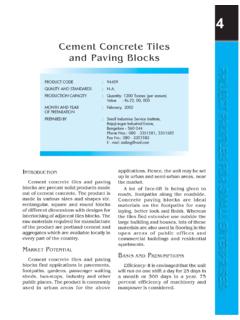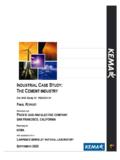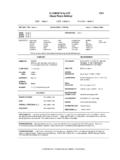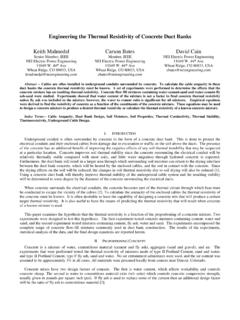Transcription of CONCRETE REFERENCE LABORATORY - CCRL
1 cement AND CONCRETE REFERENCE LABORATORY PROFICIENCY SAMPLE PROGRAM Final Report portland cement Proficiency Samples Number 205 and Number 206 August 2017 4441 Buckeystown Pike, Suite C Frederick, Maryland 21704 phone: 240-436-4800 fax: 610-834-7066 email: Sponsored by Committees C-1 and C-9 of ASTM International August 31, 2017 TO: Participants in the CCRL portland cement Proficiency Sample Program SUBJECT: Final Report on portland cement Proficiency Samples No. 205 and No. 206 Following is the final report for the current pair of CCRL portland cement Proficiency Samples which were distributed in June 2017. portland cement Samples No.
2 205 was an ASTM C150 meeting the specifications of Type I. portland cement No. 206 was an ASTM C150 meeting the specifications of Type I and Type II, and contained an inorganic processing addition. This report consists of a statistical Summary of Results, a set of general Scatter Diagrams, and associated detailed information. The Table of Results with individualized information for participating laboratories can be downloaded at our website located at: Additional information is provided in the following pages. The CCRL Proficiency Sample Programs are intended for internal use by the LABORATORY as a tool to identify potential problems in LABORATORY procedures or test equipment and to initiate remedial actions.
3 These programs are designed to complement the CCRL LABORATORY Inspection Program as part of a total quality system. Care should be taken when using this program for any other purpose. Additional samples of these two cements and other CCRL samples are available for purchase. These samples may be useful for equipment verification, technician training, and research. Contact CCRL for availability and price. It is presently anticipated that the next portland cement Proficiency Samples will be distributed in January 2018. Sincerely, Robin K. Haupt Supervisor, Proficiency Sample Programs cement and CONCRETE REFERENCE LABORATORY Explanation of Final Report - page 1 of 2 TO: Participants in the CCRL portland cement Proficiency Sample Program FROM: Robin K.
4 Haupt, Supervisor PSP SUBJECT: Explanation of Final Report on Results of Tests for portland cement Proficiency Samples No. 205 and No. 206 This letter, and the material included with it, constitutes the final report, and summary of results for the current pair of portland cement Proficiency Samples, which were distributed in June 2017. This material includes a Table of Results for individual LABORATORY data, a statistical Summary of Results, and a set of general Scatter Diagrams. Your unique LABORATORY number is displayed at the top of the individual Table of Results. An explanation of the program is contained in the paper: "Statistical Evaluation of Interlaboratory cement Tests" by J.
5 R. Crandall and R. L. Blaine , and "Statistical Aspects of the cement Testing Program" by Youden , which can be found in Volume 59, Proceedings of the 62nd Annual Meeting of the Society, June 25, 1959, American Society for Testing and Materials. Each LABORATORY receives an individualized Table of Results. The Table of Results shows the, test title, and the reporting unit in the first two columns. After that it lists in order, the LABORATORY 's results for the odd and even numbered samples, overall averages for the odd and even numbered samples, and the LABORATORY 's ratings for the odd and even samples. LABORATORY ratings, shown in the Table of Results for the individual LABORATORY , were determined in the manner described by Crandall and Blaine using a rating scale of 1 to 5 instead of 0 to 4.
6 The ratings have no valid standing beyond showing the difference between the individual LABORATORY result and the average for a particular test. The following table details the relationship between the ratings and the averages. Ratings Range (Number of Number (Per 100) Standard Deviations) of Laboratories achieving the rating 1 5 Less than 1 69 4 1 to 18 3 to 2 9 2 2 to 3 1 Greater than 1 The sign of the rating merely shows whether the result reported was greater or less than the average obtained. Participants subscribing to the primary chemical analysis portion of this report should note that the statistics were calculated using data obtained by wet methods, and rapid methods of chemical analysis.
7 Participants in the secondary chemical analysis should note that LABORATORY ratings are assigned using primary chemical statistics. Please note that individual LABORATORY ratings were not given for the flow of air content mortar (test no. 190) and compressive strength mortar (test no. 230). Air content flows in the range of are satisfactory; labs with flow values outside this range will be flagged as a Labs Eliminated or Labs Off Diagram on the scatter diagram. Averages, standard deviations, and a scatter diagram are provided for your information. This information may be a helpful indicator of a problem with flow table apparatus or mortar mixing 1 Youden, , Statistical Aspects of the cement Testing Program ,Volume 59, Proceedings of the 62nd Annual Meeting of the Society, June 25, 1959, American Society for Testing and Materials.
8 View DocumentView Document Explanation of Final Report - page 2 of 2 procedures. Flow values of 151 were assigned to laboratories reporting a mortar flow off the flow table top. In cases where some laboratories' results are eliminated, averages, standard deviations, coefficients of variation, and the ratings of the other laboratories' results, are recalculated using the data remaining after the elimination. Since the LABORATORY ratings given are the results from this one series of tests, you need not attach too much significance to a single low rating, or pair of ratings, from this one series. A continuing tendency to get low ratings on several pairs of samples should lead a LABORATORY to consider the types of error, systematic and random, contribute to ratings that are low.
9 Systematic error, which is indicated by low ratings with the same signs on each pair of samples, means a consistent error is occurring in equipment and/or test procedures. One indication of random error is low ratings on both samples with different signs. Since systematic error occurs with more regularity, its cause is generally easier to find than the cause of random error. Summary of Results Usually, averages, standard deviations, and coefficients of variation are given with all results reported, and then with one or more outlying results omitted. Sometimes, two or more recalculations with laboratories omitted, have been done for the same test. In these cases, all of the laboratories omitted in previous recalculations are also omitted in subsequent ones.
10 Results omitted are values that are more than three standard deviations from the mean of one or both samples. Often, elimination of these outlying results has little effect on the average, but may have a more pronounced effect on the standard deviation and coefficient of variation. Scatter Diagrams General scatter diagrams are supplied with this report. Crandall and Blaine describe the manner of preparing scatter diagrams, and their interpretation, in the paper published in the 1959 ASTM Proceedings. Each LABORATORY will receive a complete set of diagrams according to their subscription to the given program.








